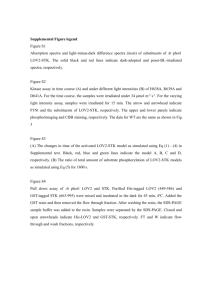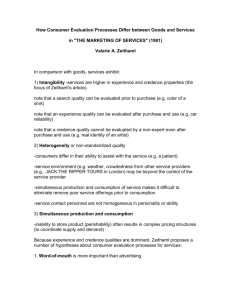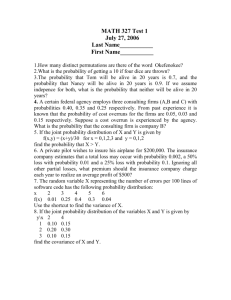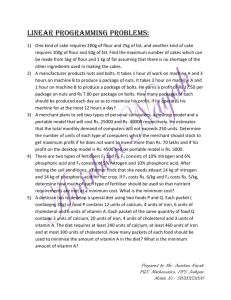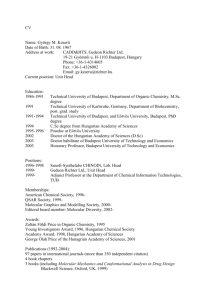The generalization of Schrady's model: with repair Norbert Becser
advertisement
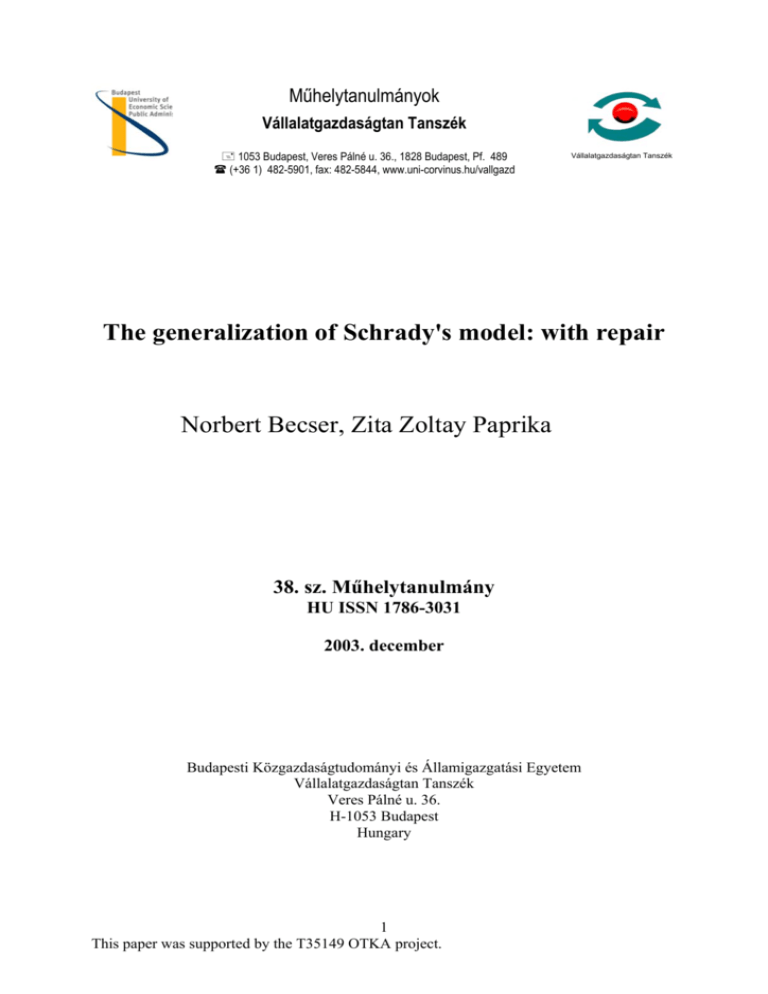
Műhelytanulmányok Vállalatgazdaságtan Tanszék 1053 Budapest, Veres Pálné u. 36., 1828 Budapest, Pf. 489 (+36 1) 482-5901, fax: 482-5844, www.uni-corvinus.hu/vallgazd Vállalatgazdaságtan Tanszék The generalization of Schrady's model: with repair Norbert Becser, Zita Zoltay Paprika 38. sz. Műhelytanulmány HU ISSN 1786-3031 2003. december Budapesti Közgazdaságtudományi és Államigazgatási Egyetem Vállalatgazdaságtan Tanszék Veres Pálné u. 36. H-1053 Budapest Hungary 1 This paper was supported by the T35149 OTKA project. A decision support model for improving service quality – SQI-DSS – a new approach Norbert Becser and Zita Zoltay-Paprika Email: benorb@westel900.net Budapest University of Economic Sciences and Public Administration Veres Pálné u. 36. H – 1053 Budapest Email: zita.paprika@bkae.hu Budapest University of Economic Sciences and Public Administration Veres Pálné u. 36. H – 1053 Budapest Abstract We are introducing a system, the basis whereof is the SERVQUAL model evaluating the quality of services, elaborated by American researchers (Zeithaml et al. 1990). Our decision support system provides help for decision making by measuring the quality of the given service in different dimensions and according to different aspects, by collecting, evaluating and presenting the data. The basic functions of the model will be presented through the case of a Hungarian enterprise. Our aim is to elaborate such an SQI-DSS (service quality improvement decision support system) that, based on the Internet and the company intranet, provides regular and categorized information, respectively – by processing them – alternatives to help decision makers make their decisions in connection with service quality improvement. Keywords: Service quality, service dimensions, quality improvement, service quality improvement decision support system Összefoglalás Egy olyan rendszert mutatunk be, amelynek alapja az amerikai kutatók által kidolgozott, a szolgáltatások minőségét értékelő SERVQUAL modell (Zeithaml, Parasuraman, Berry, 1990). Döntéstámogató rendszerünk az adott szolgáltatás minőségének különböző dimenziókban, és szempontok szerinti mérésével, az adatok összegyűjtésével, értékelésével, és prezentálásával nyújt segítséget a döntéshozatalban. A modell alapfunkcióit egy magyarországi vállalkozás esetén keresztül mutatjuk be. Célunk egy olyan SQI-DSS (szolgáltatás minőség fejlesztő döntéstámogató rendszer) kialakítása, amely az internetre és a vállalati intranetre alapozva, rendszeres, és kategorizált információkkal, illetve azok feldolgozása által cselekvési alternatívákkal segíti a döntéshozókat a szolgáltatás minőség fejlesztésére vonatkozó döntéseik meghozatalában. Keywords: szolgáltatás minőség, szolgáltatási jellemzők, minőségfejlesztés, szolgáltatásminőség fejlesztésének döntéstámogató rendszere 2 This paper was supported by the T35149 OTKA project. 1 INTRODUCTION By now, quality management has become one of the basic modules of company management systems. From quality assurance replacing quality control, we got as far as the age of quality management, where management has become a key notion, whether we talk about TQM philosophy or ISO 9000 standard systems. The top managers of industrial companies with production activities are aided by several models in choosing the appropriate direction of quality improvement but the managers of the enterprises providing services are bound to rather rely on their intuitions when making strategic decisions in connection with quality. It is especially true for the managers of enterprises serving customers with different needs, having several premises and a centralized organization, who – for lack of time and information – are not even able to make satisfactory decisions, not to talk about optimal ones. So in any case it is necessary to elaborate a model that provides help to the decision-makers so that they be able to determine the possible alternatives of action (action guidelines), respectively to choose among them the opportunities or a combination of opportunities that are most appropriate in space and time, and not least, those that suit the given customers. 2 QUALITY CONTROL – QUALITY MANAGEMENT – DECISION SUPPORT Many have tried and still try to define the notion of quality in different ways but it can be declared that there is no uniform definition at present. The definition “fitness for use” by Juran (1988) in itself makes the impression that quality rather relates to tangible things. During quality control, it was aimed that the products meet the demands made on them, whether they are at the beginning or at the end of the production process. The below steps of quality control (Juran 1988) had not yet required learning from the differences and stress was put on correcting the mistakes. - Evaluation - Compare to goals - Act on the difference Through the recognition that suitable products can be manufactured through appropriately regulated processes, the processes came more and more to the fore of examinations. The elaboration of products and processes suiting the needs of the customer (quality planning), then the quality improvement so attained gave the last impulse to the world conquest of quality management and of the quality approach. Whether we talk about the American, the Japanese or the European schools of quality, a common element in all of them is the need for improvement. Although quality assurance as a “planned and systematic activity” rather puts the stress on the “adequate confidence” evoked in the customers (EN ISO 8402:1994), the basic principles of the TQM philosophy (Tenner, DeToro 1992), or the new, standard quality management systems (e.g. EN ISO 9001:2000) already require that the company operating in their spirit should not only maintain the present quality level but should also increase it by continuous improvements. One of the best known tools of quality improvement is the PDCA (plan-do-check-act) cycle (Ishikawa 1985), the steps whereof can be complied with to the classic decision process as well. The “plan” phase means the recognition and definition of the problem. In the “do” phase the reasons of difference are examined, observations are made, data and information are collected and alternatives are established. The evaluation of the action versions, respectively the decision can be complied with the “check” phase, the implementation and the checking of the chosen alternative is connected to the last element (act) of the cycle. According to continuity, the system returns to itself and either looks for solutions for other differences or it is bound to further improve the result attained by starting a new cycle (decision process). 3 This paper was supported by the T35149 OTKA project. Quality Management PLAN DO CHECK ACT Define requirements, plan work Collect process data, Execute plan Analyze data, decide on actions Take action Decision Making Identifying problem, perceived-expected values Collect information, establish alternatives Analyze, evaluate alternatives, decide Implementation, feedback Table 1: PDCA cycle and decision making In order for a process to be improvable, it has to be constant and stable. In any case, evaluation and analytic statistical methods are necessary for improvement, whereas continuous control and feedback are needed for controllable processes and performances (Deming 1982). For example, production management today cannot be imagined without quality control and management, to which are obviously connected well-defined computerized control and support systems that operate in a stable environment with operationalized models. Quality management also uses models and expert systems that perform default analysis, test result evaluation and plan corrective actions while decision support systems can be applied for determining quality costs as well (Davis, Hamilton 1993). 3 QUALITY OF SERVICES The models that work in production can hardly be applied in the case of services. On one hand, services are intangible. They are not objects that can be measured, precisely characterized but they are some performances. It is a much more complicated and difficult task to judge them precisely and to compare them. Services are heterogeneous, performances vary from day to day, and from one service provider to the other. It is hard to imagine that we would receive the same service in every bank, every shop, or gas station. Whereas 95-octane gasoline has the same quality in every gas station, service varies from station to station. Providing and receiving a service are inseparable from each other. In the course of production, product planning, manufacturing and evaluation by the customer are separable from one another in space and time as well, whereas in the case of services, the person receiving the service meets its characteristics at the same time as the service is being provided. To summarize (Zeithaml et al. 1990): - For customers, it is harder to evaluate service quality than product quality. Thus it is harder for service providers to reveal the expectations they should meet. - Customers do not only judge a service by its outcome (e.g. the bank transaction was successful) but also consider the process of service providing (how kind and competent the bank officer was, how much time it took, etc.). - The service quality is subjective it is exclusively judged by the customer receiving it. There are many uncertainties with respect to the quality of services. It is difficult to define what we mean by good and bad service. The situation is made more complicated by the fact that different consumers consider different characteristics important in connection with the very same service. Let us consider a commercial company that serves both retail and wholesale partners. For the retail customer it is important that the store be easily accessible and esthetic, that they be served by distinguished-looking, competent personnel who can provide appropriate information on the products, and it is also possible to try the products if necessary, respectively further auxiliary services (e.g. home delivery) are also available. For 4 This paper was supported by the T35149 OTKA project. the wholesale partner of the same sales organization, other characteristics make high-quality service: satisfactory availability by phone, professional information, customized offers and customers care whereas physical appearance is less important. Quality improvement is also necessary for service providers, in order to maintain competitiveness, and not least in order to comply with the requirements given by quality systems. But in which direction should the managers go if they are not even fully aware of what customers, respectively they themselves mean by the quality of the given service? 4 THE NECESSESITY OF DSS IN SERVICE QUALITY IMPROVEMENT When preparing the decisions concerning the improvement of the production processes and of the product quality, the data – by analyzing which the action alternatives can be elaborated, respectively the consequences thereof can be assessed – can be collected, respectively are available to the decision-makers. The adequate quantitative methods that assure that optimal decisions will be made (i.e.: FMEA – Failure Mode, Effect Analysis, FMECA – Failure Mode, Effect, and Critical Analysis, FTA – Fault Tree Analysis, etc.), can be introduced and implemented. On the other hand, the choice between the action alternatives concerning service quality improvement cannot be optimal at all. The characteristics of the services (intangible character, heterogeneity, indivisible character, incomparability) already carry it within themselves that the decision situations aiming at service quality improvement are ill-structured problem situations, where the solution is not given, respectively is not trivial. The recognition of the problem already runs into difficulties, moreover its definition may depend on the evaluation of several different persons affected. It is not clear for the decision-makers, what, to what extent they have to or they can reinforce, respectively what future effects it may have. In absence of mathematical, respectively statistical methods (either because they cannot be applied or they are not available) satisfactory decisions are made, in case at least the problem itself is already recognized and defined. However in most cases the uncertainty and the changing environment move the decision-makers to make decisions based on past experiences, relying on their intuitions. Unfortunately intuitive decisions lead to the wrong direction in several cases, especially incorrect problem identification may lead to choosing not satisfactorily grounded solutions that do not work in the changed environment. In our opinion, in a fast changing, complex environment, intuitive decision-making is little effective. In order to be more effective in this situation, the following are necessary: - Determining the dimensions characterizing the given service - Creating the possibility of measuring by dimensions - Specifying the persons concerned by the given service and the evaluations by those concerned (data collection), - Elaborating a database - Carrying out analysis based on the data - Preparing proposals for the decision-makers based on the analyses - Continuous database maintenance - Making the data available to the functional fields For assuring all these tasks, an adequate decision support system (DSS) can be suitable that handles and classifies incoming data, the models used for the analysis, respectively makes the results available through some user interface to a more restricted (top managers) or wider circle (operative management). With the help of the decision support system, by collecting, classifying and analyzing information, the solution “satisfying” the goals and potentials of the organization can be reached. 5 This paper was supported by the T35149 OTKA project. 5 THE BASIS OF THE SQI-DSS SYSTEM IS THE SERVQUAL MODEL The service quality improvement decision support system (SQI-DSS) has to be both universal and unique at the same time, while it has to take an already accepted and tried model as a base for its operation. Given the characteristics of services, building up such a model is not an easy task, as the different services are described by different characteristics, in fact variability may come about according to cultures, or in time. During our research we got to know the SERVQUAL model defined by American scientists (Zeithaml et al. 1990). By studying it and trying it under Hungarian conditions, we thought it could be suitable for serving as the central element of our decision support system. We think so because the model had been improved, tested and refined for a long time – seven years. Companies acting in different branches of service took part in modeling, from banks through assurance companies to large public utility firms. SERVQUAL starts from the hypothesis that the customers’ expectations connected to the given service and the characteristics of the service perceived differ from each other. These differences can be caused by the different pitfalls of service delivery. 1. GAP 1: Customer’s expectations – Management perceptions Gap: The customers’ expectations and the managers’ perceptions on the customers’ expectations do not match. 2. GAP 2: Management’s perceptions – Service quality specifications Gap: The managers’ perceptions on the customers’ expectations and the specifications concerning service quality do not match. 3. GAP 3: Service quality specifications – Service-delivery Gap: The specifications concerning service quality and service delivery do not match. 4. GAP 4: Service delivery – External communications Gap: Service delivery and the external communications of the service characteristics do not match. 5. GAP 5: Expected service – Perceived service Gap: The actually perceived quality does not match with the service quality expected by the customer. Table 2: Gaps in service quality (Source: Zeithaml et al. 1990.) The aim of the model’s user is: - to define the dimensions through which service quality can be measured - to analyse the pitfalls creating the differences with the help of the dimensions - to choose among the dimensions to be improved and among the pitfalls to be avoided according to the decision-maker’s level of aspiration. In a complicated and changeable environment not only the characteristics of the customers’ expectations towards the service and their perceived experiences have to be compared but also the image that the company creates of itself. The difference between the present state perceived by the company managers and the customers’ perceptions has to be examined as well. 6 This paper was supported by the T35149 OTKA project. Gap 5 Communication, external influence Perceived service (customer) Expected service (customer) Befolyásoló Influencing tényezők factors Gap 1 Gap 4 Managerial perceptions on customer expectations Expected service (service provider) – level of aspiration Perceived service (service provider) Gap 3 Gap 2 Figure 1: Evaluating service quality It has to be taken into consideration that the expected quality is also affected by external and internal factors: - The expectation towards high quality may derive from the influence of somebody who has already met the given service (word-of-mouth communication), - The expectations are influenced by the customer’s personal characteristics, conditions, needs (personal needs) - Past experiences and the deeper knowledge of the given service process may make the expectations stricter or ease them - The service providers themselves can also shape the expectations by tools of external communication and persuasion. In the model we make the service quality expected by the managers correspond to their level of aspiration that they define in terms of quality standards and specifications. Based on the model, service quality can be called outstanding if according to the organizational conditions (level of aspiration), the customer’s defined and expected needs are in conformity with the perceived service. The value judgments concerning service quality are applicable for the decision-makers if they can be made measurable and comparable. The ten, respectively five dimensions defined by researchers give us exactly this opportunity. 1. Tangibles: The appearance of the company’s premises, equipment, personnel and communication tools. 2. Reliability: The company’s ability to provide the promised service in a precise and reliable manner. 3. Responsiveness: The company’s willingness to help the customers and to provide prompt service. 4. Competence: The existence of the experience, knowledge and know-how necessary for providing the service. 5. Courtesy: Friendliness, respect, attentiveness, thoughtfulness 6. Credibility: Reliability, righteousness, honesty 7. Security: Being risk-free, doubtless 7 This paper was supported by the T35149 OTKA project. 8. Access: Availability, easy access, contact 9. Communication: Informing the customer in an understandable manner. 10. Understanding the customer: The effort made to get to know the customer and their needs. Table 3: Ten dimensions of service quality (Source: Zeithaml et al. 1990.) The statistical analysis of the answers received during the creation of the model showed that there is a strong correlation between several factors, which made it possible to simplify the model by reducing the ten dimensions to five essential characteristics. The characteristics of competence, courtesy, credibility and security can be identified with guarantee, reliability factor, while access, communication and understanding can be covered by introducing the dimension of empathy. The dimensions describing service quality, elaborated by the SERVQUAL model are the following: 6 Tangibles: The appearance of the company’s premises, equipment, personnel and communication tools. Reliability: The company’s ability to provide the promised service in a precise and reliable manner. Responsiveness: The company’s willingness to help the customers and to and provide prompt service. Assurance: The experience, knowledge, courtesy of the company employees and their ability to convey confidence and reliability towards the customers. Empathy: Customized “caring” attention that the company pays to the customers. DEVELOPING/IMPROVING THE SQI-DSS Our aim is to elaborate a DSS (decision support system) that provides help to the top management of service providers in making their strategic decisions concerning quality improvement. When we were planning the system, we took into consideration the environmental conditions that make seizing service quality more difficult: - Large number of customers having different expectations - Expectations changing in space and time - The judgements concerning service quality become distorted as time elapses - Few data, respectively hard to collect - The problematic of evaluation, analysis - The uncertainty of choosing between the possible alternatives - Decision making rather based on intuitions It is necessary that the circle of customers we choose as focus groups should be definable at the given organization. According to our experiences, it is worth differentiating three levels in the case of respondents within the organization: owner (top manager), operative manager and employee in contact with the customer. This way we have to collect information necessary for operating the system from several, physically separated fields. Realizing the queries means the greatest difficulty, as questioning several groups is timeconsuming. Our researches showed that as time goes by, respondents judge the same service in a different way so it is practical to acquire the information and impressions at the same time as the service is being delivered, and transfer them to the system. For collecting the information, we need to use the opportunities offered by Internet, the telecommunication networks and the company Intranet. Customers may be queried through the Internet or by phone. Queries have to be scheduled so that they should be close to service delivery and the information has to be put immediately into the centralized system, 8 This paper was supported by the T35149 OTKA project. automatically or by operators. For querying the employees, Intranet, respectively internal networks can be used. The system automatically collects incoming information into databases and classifies them according to query period, respectively to the queried group, so preparing the data for later processing. Query is realized according to the SERVQUAL dimensions, through the questionnaires containing 22 questions, used for analysing them, where the respondents evaluate the individual statements on a specified interval scale. As far as the central database is concerned, it is enough to collect these values and to sort them out into a database. Data may be queried continually, respectively at stated intervals, as if snapshots were taken about the service quality of the given organization. Continuous queries make the system dynamic; however in our opinion, sequential (in quarterly, bi-annual and annual cycles) application is more effective, as the effects of the chosen action alternative, depending on the depth of the measure, can only be perceived later in time. Statistical methods help us in analysing the data, through simple standard deviation values to examining distribution functions. The outputs of the analyses are such graphic models and tables that clearly show to the decision-makers the alternatives, the ways of improvement, respectively the changes compared to the data of the previous period and the results of the previously chosen action alternative. The cyclical queries assure the continuous follow-up of the analyses and the examination of the effectiveness of the implementation. Managers, executives via Intranet Actions Manager Service leader Executives Manager SERVQUAL model Service leader SQI-DSS Executives Customer Customer Upper management Customer Actions Customer (retail) Customer Customer groups via internet, telecom Figure 2: Centralized DSS model In the present phase of system elaboration, we are through with testing the chosen basic model. Based on the experiences of empirical research, the SERVQUAL model perfectly suits the information collection and evaluation module of our decision support system, which we are presenting through the below case study. 9 This paper was supported by the T35149 OTKA project. 7 IMPROVING SERVICE QUALITY WITH THE HELP OF THE SERVQUAL MODEL AT A HUNGARIAN COMPANY The model was tested at a Hungarian commercial company being in 100% Hungarian ownership. The enterprise deals with car tire retail and relating services (tiring, repair, etc.), serves wholesale, retail, respectively domestic and foreign customers as well. The company headquarters are located in the Eastern region of the country, in Nyíregyháza, the national coverage is assured by ten company sites. The company has operated its quality system for several years and in this spirit, performs continuous improvement (e.g. service quality improvement). We found an ideal partner from the aspect of our research as the enterprise is operating in a complex environment carries all the characteristics that are necessary for testing our model: different kinds of customers, several, geographically separated sites, central management, strategic approach, quality orientation, venturesome management, operating company information system. The owners (top managers), although they thought they are in possession of the knowledge about the processes hindering service quality, did not have concrete information thereof. It emerged as a demand from their side to apply a system that would collect data about service (with special regard to the selling process of premium category tires) quality from the different customer groups, analyse them and provide help in decision making or would reinforce their previous intuitions. The participants of the application were the company’s top managers, site managers, salesmen/repairmen, respectively the customers (retail, wholesale). Our hypothesis was that top managers and the employees in contact with the customers see and judge certain things differently, and the same can apply to the sites and to the customers’ value judgments as well. During the survey, we analysed 10 questionnaires from the Nyíregyháza headquarters, 52 judgments from the sites and the evaluation of some 43 retail or wholesale partners. The survey was carried out based on the judgments given on a seven points scale on 22 statements related to the dimensions of the SERVQUAL model. During the survey, the respondent was asked to give answers to the same 22 questions from several aspects, respectively to evaluate the given statements from different aspects that are logically related to service pitfalls. In the research, we were looking for answers for the below questions: - What is the ideal company like in the eyes of the customers? - What is the ideal company like in the eyes of the employees? - What is the present image of the company like? The model also provides an answer on how much these three images cover one another, that is, how much the company suits the “ideal” of the ideal company and whether the employees know what customers expect from them. The model defines the improvement points and ways that move the enterprise towards being an ideal company. During the assessment, we defined the characteristics of an ideal tire selling company, which evolved based on the evaluation of the customers. According to this, the ideal tire selling and fitting company provides reliable service with employees who are able to inspire confidence in the partner and can also react to special demands in a pleasant environment and with a suitable level of care. The evaluation of own employees also reinforced this image. Their value judgments cover the customers’ image about the company very well. For them, too, a company based on confidence, providing reliable service and highly responsive to the customers’ problems means the excellence that provides a work environment fulfilling the needs. Naturally there are differences between expected and perceived quality with respect to the order of SERVQUAL dimensions. 10 This paper was supported by the T35149 OTKA project. Expected Service Dimensions Perceived Service Dimensions Reliability Reliability Assurance Empathy Empathy Assurance Tangibles Responsiveness Responsiveness Tangibles Table 4: Expected service dimensions – Perceived service dimensions: By analysing the data, we made the following observations: It can be observed that in order to reach the level of ideal company, further improvements are needed almost in every dimension, so in the fields of confidence, reliability, responsiveness and tangibility as well. We can also set up a hierarchical order between the fields to be improved in the light of how important the dimension is, respectively what the situation is in the given field. Thus the following improvement guideline can be traced: 1. It is important to reinforce reliability both in the interest of customer satisfaction and of high-quality service, which means observing the agreed deadlines, solving problems, being faultless and providing information, respectively handling complaints in a professional manner. 2. Greater confidence has to be inspired in the customer; up-to-date, unquestionable, professionally correct, fast information and help have to be provided to them in every situation, also paying attention to the customer. The customer has to be made feel that at the given moment they are the most important and the only customer for the company. This relationship has to be maintained in the future as well by “taking care of” the customer’s further requests, too. 3. In order to maintain retail customers and to increase their number, the physical appearance of the company has to be further improved by state-of-the-art equipment, workshops and not least by distinguished-looking and courteous employees. We presented the statements to the managers in graphics, too, which demonstrate even more clearly the differences, the weights and the fields to be improved. SERVQUAL dimensions 7 Empathy Tangibles 6 Reliability Expected service by managers Expected service by customers 5 Percieved service by customers Assurance Responsiveness Figure 3: Expected vs. Perceived service 11 This paper was supported by the T35149 OTKA project. The diagram expressively shows it to the decision-makers that expectations are almost identical both from the managers’ and the customers’ side: from the viewpoint of service quality, the most important ones among the dimensions are reliability and assurance, confidence. The most “laggard” field, that is, the way of quality improvement can be confidence, responsiveness and tangibility. 8 FURTHER IMRPOVEMENT According to our research, the basic idea of the planned DSS is appropriate. Taking the theoretic model as a basis, we have to further improve the Internet and intranet platform serving data collection and categorization, respectively a user-friendly interface that besides time-sequential analyses will also be able to provide help in graphic form about the improvement alternatives and their consequences by realizing continuous follow-up. Our aim is to make the system interactive in a way that the decision makers be able to weigh the individual alternatives (SERVQAUL dimensions), respectively to examine their effects, even by real-time analyses. 9 CONCLUSIONS Quality improvement projects are most characteristic in production as there are several useful models and methods available for the users. Because of the service characteristics and the complex, ill-structured decision situations, service-providing organizations so far rather made intuitive efforts for development that were less based on rationality. But service quality improvement is at least as important as improving the product or the production processes so it is necessary to elaborate a support system that helps decision-makers to generate alternatives based on the objective data between service characteristics and the improvement potentials, to choose from them and to follow up the consequences of their decisions. Our decision support system (SQI-DSS), still under development is expected to fill this gap. We have tested the SERVQUAL model serving as a base for the system and we have found it to be convenient. We think that by elaborating and implementing the system, and by exploiting the potentials offered by Internet and Intranet, we can give a great tool to the hands of managers of service providing companies. 10 REFERENCES Carter, G.M., Murray, M.P., Walker, R.G., Walker, W.E. (1992) Building organizational decision support systems, Academic Press Davis, G.B., Hamilton, S. (1993) Managing Information, Business One Irwin Deming, W.E. (1982) Quality Productivity and Competitive Position, MIT Center for Advanced Engineering Study Ishikawa, K. (1985) What is a total quality control? The Japanese way, Prentice-Hall Juran, J.M., Gryna, F.M. (1988) Juran’s Quality Control Handbook. McGraw-Hill Inc. Tenner, A.R., De Toro, I.J. (1992) Total Quality Management, Addison-Wesley Publishing Zahedi, F. (1993) Intelligent Systems for Business: Expert systems with neural networks, Wadsworth Publishing Company Zeithaml, V.A., Parasuraman, A., Berry, L.L. (1990) Delivering Quality Service. The Free Press 12 This paper was supported by the T35149 OTKA project. COPYRIGHT [Norbert Becser, Zita Zoltay-Paprika] © 2003. The authors grant a non-exclusive licence to publish this document in full in the DSS2004 Conference Proceedings. This document may be published on the World Wide Web, CD-ROM, in printed form, and on mirror sites on the World Wide Web. The authors assign to educational institutions a non-exclusive licence to use this document for personal use and in courses of instruction provided that the article is used in full and this copyright statement is reproduced. Any other usage is prohibited without the express permission of the authors. Norbert Becser is an economist and a consultant. Since 1998 he has been dealing with elaborating standard quality systems, preparation for attestation, Total Quality Management and organizational development. As a part-time Ph.D. student, he teaches Business Economics and Decision Theory courses at the Budapest University of Economic Sciences and Public Administration. His field of research is decision theory, more specifically the relationship between quality systems and decisionmaking styles, respectively the examination and improvement of quality improvement programs and projects aided by decision support systems. Zita Zoltay Paprika joined the Business Economics Department of the Budapest University of Economic Sciences in 1987. She got her Ph.D. in Business Administration in 1999. In 2000 she was appointed as the Director for International Affairs at the Budapest University of Economic Sciences and Public Administration. Her main fields of interest are Decision Theory and Business Economics. She teaches at undergraduate, graduate, postgraduate levels and in the Ph.D. Program as well. She is in charge of the following subjects: Decision Theory, Decision Methods, Decision Support Systems, Business Economics. Her English course is titled: Decision Methods. Dr. Paprika was involved in different international and national projects during which activities she was project manager on several occasions. From 1991 to 1996 she was the Hungarian co-ordinator of the TEMPUS JEP 2360 project (Business Economics and Management Support) financed by the European Union. She was also the project leader of the empirical research of the “In global competition” program conducted by the Business Economics Department. She was one of the editors of the book summarising the research results published in English and in Hungarian as well. She was also acting as the USAID auditor in project evaluations. She is the secretary of the IFIP (International Federation for Information Processing) Working Group on Decision Support Systems (WG 8.3). She also permanently works as a consultant and recently published a book on Decision Theory in Hungarian. 13 This paper was supported by the T35149 OTKA project.


